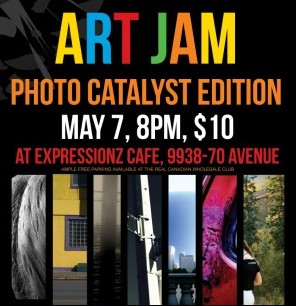At Art Jam, the interpretive doctor is in
Posted on May 6, 2011 By Rob Drinkwater Front Slider, Visual Arts
 Fancy yourself an amateur psychiatrist? Maybe you even had a little booth a few years back and charged neighbours a nickel for advice. But then the Alberta Medical Association got wind of your little operation and shut you down so fast you scarcely had time to ask about their relationship with their mother.
Fancy yourself an amateur psychiatrist? Maybe you even had a little booth a few years back and charged neighbours a nickel for advice. But then the Alberta Medical Association got wind of your little operation and shut you down so fast you scarcely had time to ask about their relationship with their mother.
Fear not. This Saturday, May 7 at 8 p.m. at Expressionz Cafe (9938 70 Ave.), you have the opportunity to play armchair shrink once again. Only this time, your patients will be a little more interesting than the bald-headed insecure boy down the street, his dog, or your blanket-toting little brother.
No, on Saturday your patients will be artists.
Here’s how it works.
Earlier this year, the organizers of Art Jam asked photographers to send in a few snaps, and then those pictures were distributed to artists who were told to create an original piece based on the inspiration they got from the photos.
The organizers of Art Jam call this event their “Photo Catalyst Edition” which will kick off a series of unusual arts events throughout the year. It bills the event as a showcase of artistic creation, and a chance to see what happens when those artists start from the same spot.
And that’s one way of looking at it. But here’s another.
The photos in this case are like a Rorschach test, also known as an inkblot test, which is a system where people are shown a series of patterns and asked for their responses. Those repsonses are then analyzed.
The work that’s on display this Saturday will be like the responses to the ink blots, only instead of responding with words, the artists are responding with art. And for the $10 price of entry, you can perform all the psychoanalysis on them you like.
Kris Kroll, one of the organizers, says it can tricky to tell how the artists got from the photo to the piece they’ve submitted. So like a problem on a math exam, they’ll be asked to explain how they arrived at their artistic destinations.
“Honestly, we can’t wait to talk to the artists and document it on video how they came to their piece — the inspiration point, the process and then the final outcome,” Kroll said.
“You don’t typically get to do that at an art show.”
The inspirational photos are varied. One shows a portrait where the person’s skin is covered in dry, cracking mud. Another photo shows a city-scape. Yet another has a rusty pickup truck.
There are more than 40 artists in total who have been organized into groups of six or seven, with each group having a mix of painters, sculptors, photographers or musicians. Each group got just one photo, and the only rule was each artist had to come up with an original piece.
“That’s the one and only rule,” Kroll says.
Remember, though, that if you plan to psychoanalyze the artists, that your interpretations of their interpretations are subjective, and are therefore open to interpretation and judgement by anyone you choose to share them with.
For that reason, you’d be wise to remember an episode of the classic TV show Get Smart where Max took a Rorschach test and responded that all the ink blots looked like men and women in various forms of embrace.
“Mr. Smart, you seem to show a definite preoccupation with men and woman hugging and kissing!” the psychiatrist exclaimed.
“Me? You’re the one with the weird picture collection!” Agent 86 retorted.











